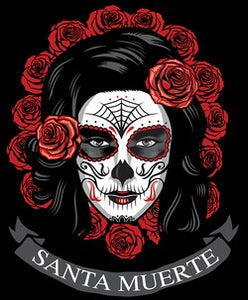Men started wearing jewelry long before women - for style, protection, and even luck. Discover these significant moments in the history of men's adornment.
The evolution of men's jewelry took a captivating turn with the emergence of jewelry inspired by Santa Muerte. These men's ornaments, blending spirituality and aesthetics, have redefined men's jewelry. Chains, symbols of strength and individuality, have become essentials, merging tradition and modernity. Santa Muerte necklaces, loaded with symbolic meanings, add a touch of mystery to men's fashion. Over time, these pieces have transitioned from mere social indicators to artistic and cultural expressions, offering men a unique way to tell their story through refined accessories.
Men's necklace Cruz de Quesada by Santa Muerte
According to the New York Times, men's jewelry is back "in fashion," thanks to the influence of hip-hop stars, athletes - and even Britain's Prince Harry, who is often seen wearing stacks of leather and bead bracelets. To celebrate the launch of our new men's collection, we decided to take a look back at men's jewelry throughout history.
1. Neanderthals were the first to wear jewelry. Historians believe they may have made the world's first jewelry about 130,000 years ago by assembling animal teeth and shells. In Croatia, researchers found a set of eagle talons from that era, which they believe were part of a necklace or bracelet, most likely worn by a man.

2. Egyptians adorned themselves to ensure a better future. In Egypt, men and women piled on gold and silver because they believed it was the way to attract the attention of their gods. The more jewelry they wore, the more attractive they were to the deities who controlled health, wealth, and the afterlife.
3. And to ward off evil spirits. Egyptians also believed that wearing symbolic amulets like the ankh or the eye of Horus could ward off evil spirits and provide spiritual guidance. They wear them as protective talismans in modern times.
4. Ancient Greek soldiers wore jewelry into battle. The leather and metal bracelets of their uniforms were an attempt at spiritual protection in combat - a practice later adopted by Roman troops.

Skull bracelet - Santa Muerte Paris
5. British royalty started the trend of heavy gold chains. Traditionally, kings distributed ornate livery collars - heavy chains, usually gold - that men wore to honor their associations. One of the most famous styles is the Collar of Esses, composed of a row of S-shaped links, made popular by Sir Thomas More in the 1500s.
6. European men popularized the single earring look. In Europe, from the late 16th century to the 17th century, it was customary for men to wear a single earring - usually a drop earring rather than a stud. The leading explorer and spy Sir Walter Raleigh was famous for accessorizing his doublet with an iconic two-bead necklace.
Men's bead bracelet Soto Lava Stone by Santa Muerte
7. Pirates and buccaneers wore jewelry as life insurance. If a sailor's body washed up on a distant shore, the gold earring was meant to pay for a proper Christian burial.
8. Gemstones were a symbol of social status. For a time in Europe, only the wealthy and high-ranking church officials were allowed to wear gemstones. British monarch Henry VIII owned at least 234 rings, 324 brooches, plus multiple necklaces studded with diamonds and beads in his jewelry collection.
9. The necessity of wartime inspired peacetime style. In the 20th century, men's dog tags and ID bracelets became a very popular fashion element. Many men adopted this style as a nod to American soldiers of World War II who wore "dog tags" for identification purposes.




